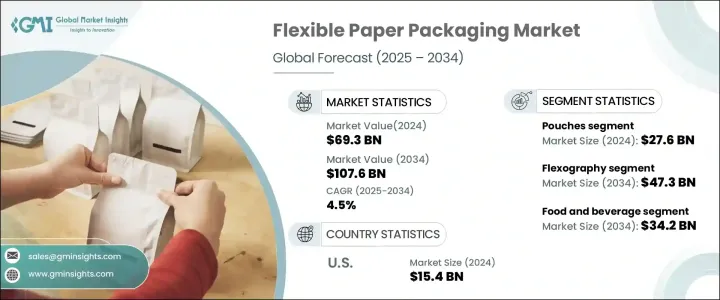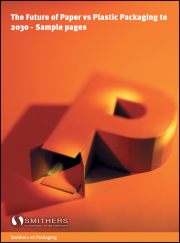
|
시장보고서
상품코드
1716537
종이 연포장 시장 : 기회, 성장 촉진요인, 산업 동향 분석 및 예측(2025-2034년)Flexible Paper Packaging Market Opportunity, Growth Drivers, Industry Trend Analysis, and Forecast 2025 - 2034 |
||||||
세계의 종이 연포장 시장은 2024년에 693억 달러로 평가되었고, 2025년부터 2034년에 걸쳐 CAGR 4.5%로 성장할 것으로 예측됩니다.
이러한 시장 성장세는 특히 식품 산업에서 탄소 배출에 대한 우려가 커지면서 보다 지속 가능한 포장 솔루션으로의 전환이 촉진된 데 따른 것입니다. 글로벌 지속 가능성 노력이 탄력을 받으면서 다양한 산업 분야의 기업들이 탄소 발자국을 줄이기 위해 환경 친화적인 대안을 채택하고 있습니다. 특히 식음료 분야에서 가볍고 생분해되며 재활용이 가능한 종이 연포장이 선호되고 있습니다. 친환경에 대한 소비자의 인식이 높아지면서 제조업체는 변화하는 소비자 선호도에 맞춰 혁신적인 종이 기반 포장 솔루션을 도입하여 이에 대응하고 있습니다.

또한 전자상거래의 급속한 확장으로 온라인 소매업체들이 안전하고 비용 효율적인 제품 배송을 보장하는 가볍고 보호 기능이 있는 소재를 찾으면서 종이 연포장에 대한 수요가 증가하고 있습니다. 엄격한 환경 규제 시행과 함께 폐기물 감소에 대한 관심이 높아지면서 산업 전반에서 종이 연포장의 도입이 더욱 가속화되고 있습니다. 지속 가능성이 선택이 아닌 업계 표준이 되면서 시장 참여자들은 기능성과 환경적 이점을 모두 제공하는 고급 종이 포장재를 만들기 위해 연구 개발에 많은 투자를 하고 있습니다.
| 시장 범위 | |
|---|---|
| 시작 연도 | 2024년 |
| 예측 연도 | 2025-2034년 |
| 시작 금액 | 693억 달러 |
| 예측 금액 | 1,076억 달러 |
| CAGR | 4.5% |
종이 연포장 시장에는 롤 스톡, 파우치, 수축 슬리브, 랩 등 다양한 제품 유형을 포함합니다. 이 중 파우치 부문은 2024년에 276억 달러의 매출을 올렸습니다. 파우치는 다용도성, 가벼운 디자인, 뛰어난 보호 기능으로 인해 식음료 및 개인 위생용품 산업의 포장 용도로 큰 인기를 얻고 있습니다. 소비자들은 편리하고 재밀봉이 가능하며 사용하기 쉬운 파우치의 기능 때문에 점점 더 파우치를 선호하고 있습니다. 업계에서 지속 가능하고 사용자 친화적인 포장 솔루션을 계속 강조함에 따라 파우치에 대한 수요는 계속 강세를 보일 것으로 예상됩니다. 또한 파우치 제조 공정의 기술 발전으로 내구성이 향상되고 전반적인 소비자 경험이 개선되면서 시장 입지를 강화하고자 하는 브랜드가 파우치를 선택하고 있습니다.
인쇄 기술 측면에서 종이 연포장 시장은 그라비아, 플렉소 인쇄, 디지털 인쇄 등과 같은 범주로 분류됩니다. 플렉소그래피 부문은 2034년까지 미화 473억 달러에 달하는 상당한 성장을 보일 것으로 예상됩니다. 플렉소그래피의 인기는 빠르게 건조되는 저점도 잉크를 사용하여 더 빠른 인쇄 속도와 비용 효율적인 생산 공정을 가능하게 하는 능력에서 비롯됩니다. 이 기술은 우수한 인쇄 품질을 유지하면서 생산 효율성을 최적화하고자 하는 제조업체에서 선호도가 높습니다. 브랜드 가시성과 진열대 매력을 향상시키는 고품질 포장에 대한 수요가 증가함에 따라 플렉소그래피는 이러한 진화하는 산업 요구 사항을 충족하는 데 중추적인 역할을 할 것으로 예상됩니다. 또한 지속 가능한 잉크와 인쇄 방법에 대한 관심이 높아지면서 플렉소그래피에 대한 수요가 더욱 증가하여 종이 연포장 시장의 핵심 성장 동력으로 자리매김하고 있습니다.
미국의 종이 연포장 시장은 2024년 154억 달러 규모로 평가되었으며 환경적으로 지속 가능한 관행을 구현하는 데 계속해서 앞장서고 있습니다. 생산자책임재활용제도(EPR)와 같은 미국의 정책은 재활용 관행을 개선하고 포장재 부문에서 폐기물을 줄이는 데 앞장서고 있습니다. 이러한 규제로 인해 기업들은 더 광범위한 지속가능성 목표에 맞춰 재활용 및 생분해성 포장재를 채택하도록 장려하고 있습니다. 친환경 포장재에 대한 소비자 인식이 높아지면서 미국에서 활동하는 브랜드들은 규제 기준을 충족하는 동시에 브랜드 충성도를 높이는 지속 가능한 솔루션을 제공하기 위해 총력을 기울이고 있습니다. 환경 보호에 대한 미국의 적극적인 자세는 기업들이 수익성과 환경적 책임의 균형을 맞추기 위해 노력함에 따라 종이 연포장 시장이 지속적으로 성장할 수 있는 발판을 마련하고 있습니다.
목차
제1장 조사 방법과 조사 범위
제2장 주요 요약
제3장 업계 인사이트
- 생태계 분석
- 업계에 미치는 영향요인
- 성장 촉진요인
- 지속 가능한 포장에 대한 수요 증가
- 경질 포장 대비 비용 효율성
- 편리성을 요구하는 소비자 증가
- 재료 기술의 발전
- 친환경 솔루션에 대한 규제 지원
- 함정과 과제
- 원재료 가격 변동
- 혁신을위한 높은 초기 자본 투자
- 성장 촉진요인
- 잠재성장력의 분석
- 규제 상황
- 기술 상황
- 장래 시장 동향
- 갭 분석
- Porter's Five Forces 분석
- PESTEL 분석
제4장 경쟁 구도
- 소개
- 기업 점유율 분석
- 주요 시장 기업의 경쟁 분석
- 경쟁 포지셔닝 매트릭스
- 전략 대시보드
제5장 시장 추계 및 예측 : 유형별(2021-2034년)
- 주요 동향
- 파우치
- 롤 스톡
- 수축 슬리브
- 랩
- 기타
제6장 시장 추계 및 예측 : 인쇄 기술별(2021-2034년)
- 주요 동향
- 플렉소 인쇄
- 그라비아
- 디지털 인쇄
- 기타
제7장 시장 추계 및 예측 : 최종 용도별(2021-2034년)
- 주요 동향
- 식음료
- 소매 및 소비재
- 의약품 및 의료
- 퍼스널케어
- 기타
제8장 시장 추계 및 예측 : 지역별(2021-2034년)
- 주요 동향
- 북미
- 미국
- 캐나다
- 유럽
- 독일
- 영국
- 프랑스
- 스페인
- 이탈리아
- 네덜란드
- 아시아태평양
- 중국
- 인도
- 일본
- 호주
- 한국
- 라틴아메리카
- 브라질
- 멕시코
- 아르헨티나
- 중동 및 아프리카
- 사우디아라비아
- 남아프리카
- 아랍에미리트(UAE)
제9장 기업 프로파일
- Amcor plc
- Berry Global Group, Inc.
- Constantia Flexibles Group
- Coveris Holdings SA
- DS Smith plc
- Graphic Packaging International, LLC
- Huhtamaki Oyj
- International Paper Company
- Mondi Group
- ProAmpac Holdings, Inc.
- Sealed Air Corporation
- Smurfit Kappa Group
- Sonoco Products Company
- UFlex Limited
- WestRock Company
The Global Flexible Paper Packaging Market reached USD 69.3 billion in 2024 and is projected to grow at a CAGR of 4.5% from 2025 to 2034. The market growth trajectory is largely driven by increasing concerns over carbon emissions, particularly in the food industry, prompting a shift toward more sustainable packaging solutions. As global sustainability initiatives gain momentum, companies across industries are adopting environmentally friendly alternatives to reduce their carbon footprint. Flexible paper packaging is emerging as a preferred choice, especially in the food and beverage sectors, due to its lightweight, biodegradable, and recyclable nature. With consumers becoming more conscious of eco-friendly practices, manufacturers are responding by introducing innovative paper-based packaging solutions that align with changing consumer preferences.

Additionally, the rapid expansion of e-commerce is fueling the demand for flexible paper packaging, as online retailers seek lightweight, protective materials that ensure safe and cost-effective delivery of products. The growing focus on waste reduction, coupled with the implementation of stringent environmental regulations, is further accelerating the adoption of flexible paper packaging across industries. As sustainability becomes an industry standard rather than an option, market participants are investing heavily in research and development to create advanced paper packaging materials that offer both functionality and environmental benefits.
| Market Scope | |
|---|---|
| Start Year | 2024 |
| Forecast Year | 2025-2034 |
| Start Value | $69.3 Billion |
| Forecast Value | $107.6 Billion |
| CAGR | 4.5% |
The flexible paper packaging market encompasses various product types, including roll stock, pouches, shrink sleeves, wraps, and others. Among these, the pouches segment generated USD 27.6 billion in 2024. Pouches are gaining immense popularity due to their versatility, lightweight design, and excellent barrier protection, making them ideal for packaging applications in the food, beverage, and personal care industries. Consumers are increasingly drawn to pouches because of their convenient, resealable, and easy-to-use features. As industries continue to emphasize sustainable, user-friendly packaging solutions, the demand for pouches is anticipated to remain strong. Moreover, technological advancements in pouch manufacturing processes are enhancing their durability and improving the overall consumer experience, making them a go-to choice for brands looking to strengthen their market presence.
In terms of printing technology, the flexible paper packaging market is segmented into categories such as rotogravure, flexography, digital printing, and others. The flexography segment is expected to witness substantial growth, reaching USD 47.3 billion by 2034. Flexography's popularity stems from its ability to utilize low-viscosity inks that dry quickly, enabling faster printing speeds and cost-effective production processes. This technology is highly favored by manufacturers seeking to optimize production efficiency while maintaining superior print quality. With increasing demand for high-quality packaging that enhances brand visibility and shelf appeal, flexography is set to play a pivotal role in meeting these evolving industry requirements. Additionally, the growing emphasis on sustainable inks and printing methods is further bolstering the demand for flexography, positioning it as a key driver of growth in the flexible paper packaging market.
The U.S. Flexible Paper Packaging Market was valued at USD 15.4 billion in 2024 and continues to lead the way in implementing environmentally sustainable practices. U.S. policies such as Extended Producer Responsibility (EPR) are driving improvements in recycling practices and reducing waste in the packaging sector. This regulatory push is encouraging companies to adopt recyclable and biodegradable packaging materials, aligning with broader sustainability goals. As consumer awareness regarding eco-friendly packaging grows, brands operating in the U.S. are making concerted efforts to meet regulatory standards while delivering sustainable solutions that enhance brand loyalty. The country's proactive stance on environmental conservation is setting the stage for continued growth in the flexible paper packaging market as companies strive to balance profitability with environmental responsibility.
Table of Contents
Chapter 1 Methodology and Scope
- 1.1 Market scope and definitions
- 1.2 Research design
- 1.2.1 Research approach
- 1.2.2 Data collection methods
- 1.3 Base estimates and calculations
- 1.3.1 Base year calculation
- 1.3.2 Key trends for market estimation
- 1.4 Forecast model
- 1.5 Primary research and validation
- 1.5.1 Primary sources
- 1.5.2 Data mining sources
Chapter 2 Executive Summary
- 2.1 Industry 360° synopsis
Chapter 3 Industry Insights
- 3.1 Industry ecosystem analysis
- 3.2 Industry impact forces
- 3.2.1 Growth drivers
- 3.2.1.1 Growing demand for sustainable packaging
- 3.2.1.2 Cost-effectiveness compared to rigid packaging
- 3.2.1.3 Increasing consumer preference for convenience
- 3.2.1.4 Advancements in material technology
- 3.2.1.5 Regulatory support for eco-friendly solutions
- 3.2.2 pitfalls and challenges
- 3.2.2.1 Volatility in raw material prices
- 3.2.2.2 High initial capital investment for innovation
- 3.2.1 Growth drivers
- 3.3 Growth potential analysis
- 3.4 Regulatory landscape
- 3.5 Technology landscape
- 3.6 Future market trends
- 3.7 Gap analysis
- 3.8 Porter's analysis
- 3.9 PESTEL analysis
Chapter 4 Competitive Landscape, 2024
- 4.1 Introduction
- 4.2 Company market share analysis
- 4.3 Competitive analysis of major market players
- 4.4 Competitive positioning matrix
- 4.5 Strategy dashboard
Chapter 5 Market Estimates and Forecast, By Type, 2021 – 2034 ($ Mn)
- 5.1 Key trends
- 5.2 Pouches
- 5.3 Roll stock
- 5.4 Shrink sleeves
- 5.5 Wraps
- 5.6 Others
Chapter 6 Market Estimates and Forecast, By Printing Technology, 2021 – 2034 ($ Mn)
- 6.1 Key trends
- 6.2 Flexography
- 6.3 Rotogravure
- 6.4 Digital printing
- 6.5 Others
Chapter 7 Market Estimates and Forecast, By End Use, 2021 – 2034 ($ Mn)
- 7.1 Key trends
- 7.2 Food and beverage
- 7.3 Retail and consumer goods
- 7.4 Pharmaceuticals and healthcare
- 7.5 Personal care
- 7.6 Others
Chapter 8 Market Estimates and Forecast, By Region, 2021 – 2034 ($ Mn)
- 8.1 Key trends
- 8.2 North America
- 8.2.1 U.S.
- 8.2.2 Canada
- 8.3 Europe
- 8.3.1 Germany
- 8.3.2 UK
- 8.3.3 France
- 8.3.4 Spain
- 8.3.5 Italy
- 8.3.6 Netherlands
- 8.4 Asia Pacific
- 8.4.1 China
- 8.4.2 India
- 8.4.3 Japan
- 8.4.4 Australia
- 8.4.5 South Korea
- 8.5 Latin America
- 8.5.1 Brazil
- 8.5.2 Mexico
- 8.5.3 Argentina
- 8.6 Middle East and Africa
- 8.6.1 Saudi Arabia
- 8.6.2 South Africa
- 8.6.3 UAE
Chapter 9 Company Profiles
- 9.1 Amcor plc
- 9.2 Berry Global Group, Inc.
- 9.3 Constantia Flexibles Group
- 9.4 Coveris Holdings S.A.
- 9.5 DS Smith plc
- 9.6 Graphic Packaging International, LLC
- 9.7 Huhtamaki Oyj
- 9.8 International Paper Company
- 9.9 Mondi Group
- 9.10 ProAmpac Holdings, Inc.
- 9.11 Sealed Air Corporation
- 9.12 Smurfit Kappa Group
- 9.13 Sonoco Products Company
- 9.14 UFlex Limited
- 9.15 WestRock Company



















